The Arts on Stamps of the World — August 28
An Arts Fuse regular feature: the arts on stamps of the world.
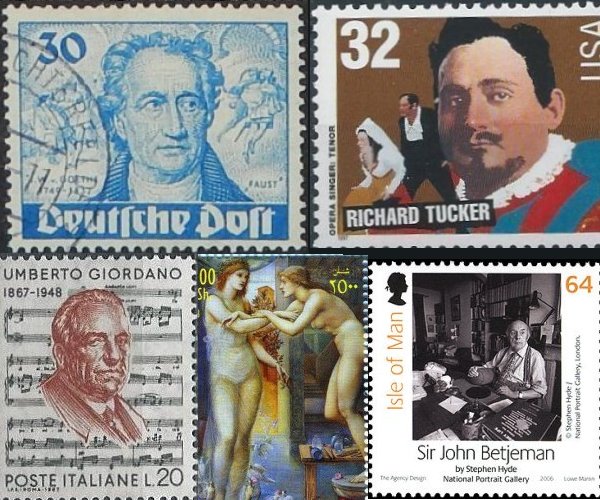
By Doug Briscoe
No doubt about it, Goethe is king today. But hold on to your hats as we also salute Sir Edward Burne-Jones, Umberto Giordano, Karl Böhm, Richard Tucker, Sir John Betjeman, and Robertson Davies! And—but you knew this—that’s not all.
Johann Wolfgang von Goethe (28 August 1749 – 22 March 1832) has been a huge inspiration for hundreds of composers from his own time to the present; Emily Ezust’s LiederNet lists over 2,700 different settings of his poems: I dare say that every single great composer of Lieder from Mozart on has set Goethe at one time or another. Non-vocal works include Dukas’s famous “L’apprenti sorcier”, The Sorcerer’s Apprentice of 1897. The profusion of worldwide stamps in Goethe’s honor is also impressive. I show just a sampling. German issues alone make up the top two rows of my collage.
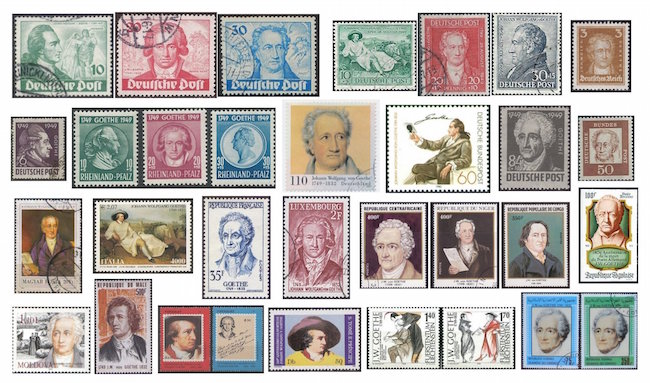
French painter Constant Troyon (August 28, 1810 – February 21, 1865) produced mainly landscapes in his younger days and pictures with animals, especially cattle, later on, as exemplified on the Hungarian stamp showing The Cowherd (aka Before the Storm, c1860). Those in the know say his earlier pieces are less worthy.
With the resurgence of interest in the Pre-Raphelites, I would have thought Sir Edward Burne-Jones (28 August 1833 – 17 June 1898) would be represented on many third-world souvenir sheets, but I found only one from Somalia, besides a couple of British issues and one of Paraguay. The Somalian sheet is a bit unusual, I think, in that none of the paintings shown is among the more familiar of Burne-Jones’s works. An ardent lover of the Pre-Raphelites myself, I had to go hunting for the titles of these pieces, which were unknown to me. At upper left is one of the paintings from the series Pygmalion and the Image. Burne-Jones executed two series of four paintings each, essentially the same conceptions differently handled. The third of the group, The Godhead Fires, is seen in the later version of 1878. For comparison, here is a link to the earlier one of 1868-70. Next to that is Hope in Prison, very similar to another piece called Hope, which was commissioned by a Massachusetts woman in 1896 and which you can see right here in Boston at the MFA if you’re so inclined. At bottom left—and on the adjacent Paraguayan issue of 1974—is a detail from Bath of Venus, and lastly we have The Mermaid (1882). The two British stamps show, first, one of Burne-Jones’s many stained glass designs, The Merchant’s Daughter, and then on a stamp commemorating Alfred Lord Tennyson a suggestion of one of my very favorite things, The Beguiling of Merlin (1874).
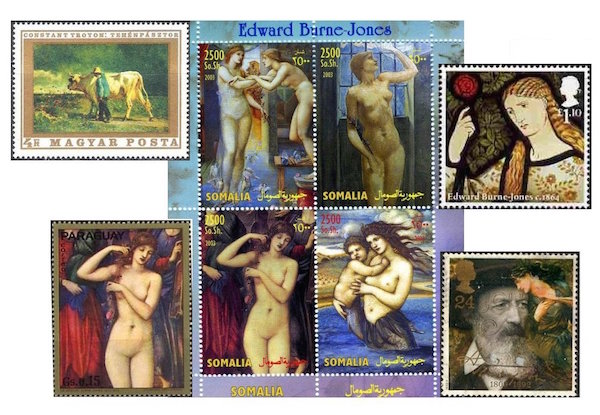
Russian engineer and architect Vladimir Shukhov (28 August [O.S. 16 August] 1853 – 2 February 1939) devised new methods in structural engineering and was the first to create hyperboloid structures. One such can be seen in the stamp design to the side of the portrait. Shukhov made about two hundred of these all over the world, the first in Nizhny Novgorod in 1896 and the most famous the 160-meter Shukhov Tower in Moscow (1922). He was also an avid amateur photographer, anticipating in some aspects fine art photography and leaving some 2,000 images. As an inventor Shukhov has been styled the “Russian Edison”. He invented the first molecular cracking method in chemistry (1891), among other innovations useful to the oil industry. He also built more than 180 bridges and designed metal-and-glass vaults like the one over the Upper Trading Rows (1893) at the GUM (State Department Store) in Moscow.
The music on the centenary stamp for Italian opera composer Umberto Giordano (1867 – 12 November 1948) is from his best known work, the opera Andréa Chenier (1896). His “runner-up” opera, Fedora (1898), still put on from time to time nowadays, was premiered with Caruso.
Colombian composer Luis Antonio Calvo (1882 – 22 April 1945), abandoned by his father, studied violin and piano and began composing at an early age. In 1907 he attended the music academy at Bogotá to study cello under Guillermo Uribe Holguín. Somehow he contracted leprosy in 1916 and retired to the colony of Agua de Dios, but he survived and may possibly even have been cured of the dreaded disease. His compositions include mainly dances such as tangos and waltzes, but also three melodramas, an operetta, and sacred works.
Karl Böhm (1894 – 14 August 1981) was one of the most respected conductors of the 20th century, specializing in Mozart, Beethoven, and Wagner and leaving a legacy of many fine recordings. An interesting side note about him was that his son Karlheinz, known as “Carl Boehm”, was an actor who played the lead in Michael Powell’s 1960 film Peeping Tom.
The Indian (Urdu) poet and critic Raghupati Sahay (28 August 1896 – 3 March 1982) is better known by his pseudonym Firaq Gorakhpuri. He produced a dozen volumes of poetry, the foremost being Gul-e-Naghma (Lyrical Flowers, 1959). He also wrote four books of prose in English on literature and culture.
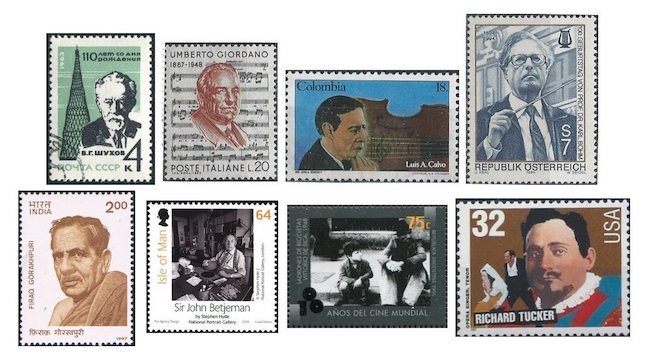
Poet Laureate of the United Kingdom from 1972 until his death on 19 May 1984, Sir John Betjeman (born 28 August 1906) had some noteworthy teachers in his youth, the likes of T.S. Eliot and C.S. Lewis, no less. (He and Lewis detested each other.) It was Betjeman who, by bringing his teddy bear to Oxford, inspired the character of Sebastian Flyte in Evelyn Waugh’s Brideshead Revisited. He loved Victorian architecture and in later years was a frequent speaker on British television.
Italian actor Lamberto Maggiorani (28 August 1909 – 22 April 1983) is known for the lead role of Antonio Ricci in Vittorio de Sica’s Bicycle Thieves. Unfotunately, this, his first acting job, did not open any doors for his future career, though he did appear in small parts in several more films, including an uncredited walk-on in Umberto D. (1952). He is seen with young co-star Enzo Staiola in a still from Bicycle Thieves on an Argentine stamp celebrating great films.
Celebrated American tenor Richard Tucker (August 28, 1913 – January 8, 1975) was born Rivn Ticker in Brooklyn to Jews from Bessarabia two years after they came to this country. His parents changed their name to Tucker before the boy went to school. He sang as a cantor, and it was through his brother-in-law Jan Peerce that he was introduced to opera, although Peerce discouraged him from pursuing a career in the field. He was, however, heard by then general manager of the Met Edward Johnson (whose birthday we just marked last week) and given a contract. Tucker first appeared on the Met stage as Enzo in Ponchielli’s La Gioconda on January 25, 1945, and his tenure as one of the star tenors of the era continued for thirty more years. He maintained his devotion to cantorial singing, too. His funeral was uniquely (so far) held on the stage of the Metropolitan Opera.
I get to enthuse about two of my favorites today: Edward Burne-Jones and the Canadian novelist (trilogist) Robertson Davies (28 August 1913 – 2 December 1995). His first published book was a 200-page work of literary history, Shakespeare’s Boy Actors (1939), which I’d love to read, but it’s hard to find a (reasonably priced) copy today. Davies did a bit of acting himself in London before returning to Canada. (He had acquired his degree at Balliol College, Oxford.) He wrote a good number of plays in the 1940s and 50s (and a few later), as well as criticism, essays, and the libretti for three stage works, two by composer Derek Holman and one on Apuleius’s The Golden Ass (1999) for Randolph Peters. Among Davies’s dear friends he numbered John Kenneth Galbraith and John Irving.
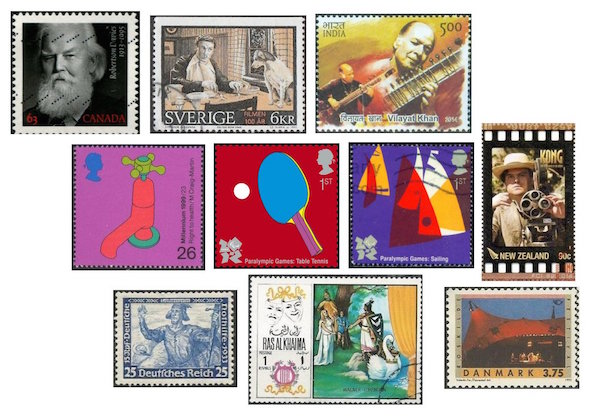
Swedish screenwriter and director Lars-Eric Kjellgren (28 August 1918 – 10 February 2003) started in the film industry as a writer in 1942. His first movie as a director was the musical comedy Don’t Give Up (1947), and the next year he went on to make Private Bom, the first in an unrelated series of comedies about the character Fabian Bom, played by Nils Poppe. The stamp shows a still with Poppe from this film. But soon Kjellgren was turning to more serious social issues in his work. Altogether he directed about twenty films until 1961—I was unable to learn why he retired from filmmaking thereafter.
Vilayat Khan (28 August 1928[1] – 13 March 2004) was one of the most prominent Bengali sitar players. His father and grandfather before him had been noted players of the instrument, as are his son and daughter and three nephews. Khan made his first recording at the age of eight and gave his first public concert, a very well received one, at 16. Besides his decades of performing, Vilayat Khan composed four film scores, which he also conducted: among them scores for Satyajit Ray‘s Jalsaghar (1958) and Merchant-Ivory’s The Guru (1969).
Born on 28 August 1941 in Dublin, artist Sir Michael Craig-Martin attended Fordham and Yale Universities, where he attributed his knowledge of color to the teachings of Josef Albers. From 1966 he has lived and worked in London. He is probably best known for his conceptual art work An Oak Tree (1973), but his canvas and fresco art tends to look more like the postage stamps he has designed for the Royal Mail. One of these was on the theme of citizens’ right to health. More recently he created some stamps, of which I show two, for the 2012 Paralympic Games held in London.
Happy birthday to American actor, singer, and comedian Jack Black (born Thomas Jacob Black on August 28, 1969), whom we find on a New Zealand stamp because of his role in Peter Jackson’s King Kong.
Wagner’s Lohengrin was first heard on this date 167 years ago in Weimar under the direction of Franz Liszt. Again we turn to the 1933 Wagner set that came out in the earliest days of the Third Reich, this time accompanied by another Lohengrin stamp from Ras al Khaima.
The Roskilde Festival is the largest popular music festival in northern Europe. Held south of the city of Roskilde, Denmark, since August 28 and 29, 1971, it was commemorated on a Danish stamp in 1995. The festival regularly draws crowds in excess of 100,000.
No stamps yet for two distinguished screen stars, Charles Boyer (28 August 1899 – 26 August 1978) and Donald O’Connor (August 28, 1925 – September 27, 2003).
A graduate of the University of Massachusetts with a B.A. in English, Doug Briscoe worked in Boston classical music radio, at WCRB, WGBH, and WBUR, for about 25 years, beginning in 1977. He has the curious distinction of having succeeded Robert J. Lurtsema twice, first as host of WGBH’s weekday morning classical music program in 1993, then as host of the weekend program when Robert J.’s health failed in 2000. Doug also wrote liner notes for several of the late Gunther Schuller’s GM Recordings releases as well as program notes for the Boston Classical Orchestra. For the past few years he’s been posting a Facebook “blog” of classical music on stamps of the world, which has now been expanded to encompass all the arts for The Arts Fuse.
